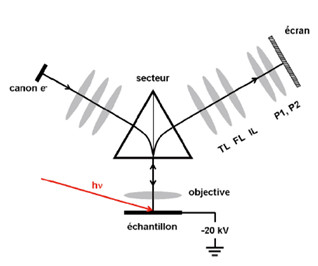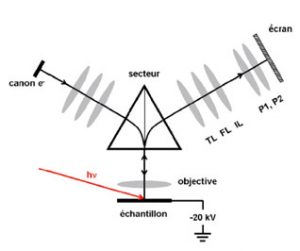LEEM and XPEEM
There are two basic PEEM conceptions, each of them are optimized according to its application.
The first is based on the electron microscopy technology developed by Telieps and Bauer. The sample is negative biased relative to the objective lens, typically -20kV, as illustrated in right side figure. The lenses are magnetic. This concept has been commercially implemented by Elmitec GmbH, and with special geometries in SPECS GmbH product. So far, most of PEEMs installed in synchrotron beamline aref in this type. There are two advantages for having the very high electron energy in the column of PEEM. Firstly, the imaging condition corresponds to the approximately Gaussian optics. That is, the concerned electrons are very close to the optics axes. This allow us to achieve the very small field of view, typically 1 µm. It may also allow us to anticipate an aberration corrected system, similar to the one used in transmission electron microscopy. One of advantages of using magnetic lens is the inclusion of a sector field which alternates the entry of electron beam for working in LEED mode and the detection of photoelectron in PEEM mode. The advantage of LEEM is the intensity of the beam, which permit the fast scan on the sample surface with high spatial resolution, and also the possibility of using special mode of microscopy, like the mirror electron microscopy (MEM). The electrons are decelerated till a limited kinetic energy so that it will be reflected before reach the surface of sample. The reflectivity is then considerably enhanced, while the transmission is very small. Thus, the electrons interact with the electrical field on the top of sample surface. This allows us to study, for example, the distribution of the surface dipoles. We use the LEEM-III system at IRAMIS SPCSI.
The second concept used in PEEM is presented by the system with pure electrostatic lens, as shown in leftside figure. The potential of the sample is near ground, while the extraction lens is at a positive high voltage. This concept is commercially realized by Focus GmbH and Omicron NanoTechnology GmbH. Compared with the first concept, it is simpler for two reasons. Firstly, it avoids the intrinsic problem derived from the application of high voltage into sample. Secondly, the optics are electrostatic: when the magnification of image changes, there is no rotation of the images, contrary to the system with magnetic lens. Thus successive zoom in the interested region or surface structure become simpler. One disadvantage of this type of PEEM is the lack of the magnetic sector in the optics, which makes the integration with a LEEM difficult. Most laboratory-based PEEMs use this concept.
One novel electrostatic PEEM instrument (the NanoESCA) is designed with a photoelectron microscope and a double hemispherical analyser whose symmetric configuration avoids the spherical aberration inherent for standard hemispherical analysers, as shown below. The optimized transmission of the instrument allows selection of a wide range of kinetic energies. The analyser allows high transmission imaging at kinetic energies far from threshhold without sacrificing the lateral and energy resolution of the instrument. High transmission is particularly important especially for highest resolution imaging XPS with monochromated laboratory X-ray sources. High spatial and energy resolution can be achieved by the fully energy filtered XPEEM, the spatial resolution down to a few tens of nanometers have been achieved. In addition, synchrotron-based XPEEM is one of the most powerful spectro-microscopic techniques for studying the chemical and electronic structures of thin film systems, combined with the tunability and polarizability of x-ray sources and high brilliance of synchrotron radiation sources.
* The XPEEM imaging at the CEA is a joint project bringing together a fundamental research institution, IRAMIS, and a technological research institution, LETI/MINATEC.

APPLICATIONS
Measurements with synchrotron and laboratory ultra-violet light show the broad field of applications including core level electrons imaging with chemical shift identification, high resolution threshold photoelectron emission microscopy (PEEM), work function imaging and band structure imaging.
Spatially resolved surface chemical state analysis (down to 50 nm)XPEEM can provide the elemental map of preferential grafting of p-MAN polymer on a gold patterned silicon substrate. The chemical nature (gold) of the unidentified nanoparticles observed in Scanning Electron Microscopy (SEM) is confirmed by the XPEEM analysis. The different chemical states of oxygen bound to silicon and to titanium are observable in the local spectra reconstructed from the image series.
Details refer to O. Renault, N. Barrett, A. Bailly, L.F. Zagonel, D. Mariolle, J.C. Cezar, N.B.Brookes, K. Winkler, B. Krömker, D.Funnemann, Surf. Sci. 601 (2007) 4727-4732
Study the spatial and momentum resolved electronic structure-directly band structure imagingThe use of a novel design of a photoelectron microscope in combination to an imaging energy filter for momentum resolved photoelectron detection. Together with a time resolved imaging detector, it is possible to combine spatial, momentum, energy, and time resolution of photoelctrons within the same instrument. The time resolution of this type of energy analyzer can be reduced to below 100 ps. The complete ARUPS pattern of a Cu(111) sample, excited with He I, is imaged in parallel and energy resolved up to the photoelectron emission horizon. Excited with a mercury light source hv=4.9 eV, the Schockley surface state at the energy threshold is clearly imaged in k-space. Figure shows a k-space image of Cu(111) taken at the Fermi energy with an exposure time of 5 min excited with He I. The small ring in the center is the Shockley surface state. The surface Brillouin zone is marked by a black hexagon.
Details refer to B. Krömker, M. Escher, D. Funnemann, D. Hartung, H. Engelhard, J. Kirschner, Rev. Sci. Instrum.79 (2008) 053702
Orientation-dependent work function of perovskite oxides studied by XPEEM
The surface composition of polycrystalline Nb-doped strontium titanate (SrTiO3:Nb) is studied using XPEEM for various grain orientations in order to characterize the surface chemistry with high spatial resolution. The surface sensitivity is maximized by the use of soft x-ray synchrotron radiation (SR). The grain orientation is determined by electron backscattering diffraction (EBSD). Stereographic plots are used to show the correlation between surface assigned to major orientation.
Details refer to L.F. Zagonel, N. Barrett, O. Renault, A.Bailly, M. Bäurer, M. Hoffmann, Shao-Ju Shih, D. Cockayne, Surf. Interface Anal. 40 (2008) 1709-1712
* Supported by EU contract NMP3-CT-2005-013862 (INCEMS)




